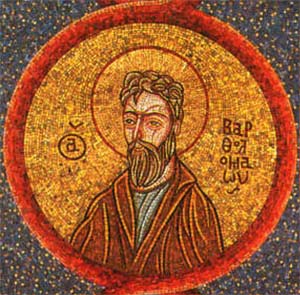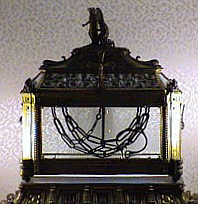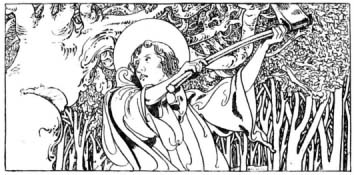Today is the Nativity of St. John the Baptist |
The Church celebrates only three birthdays: our Lord’s, our Lady’s, and St. John the Baptist’s. The other saints’ days are heavenly birthdays, when the saint died or was martyred and went to Heaven. John fulfills the prophecy of Malachi, “Behold, I send my messenger before thy face, which shall prepare thy way before thee.” (Malachi 3:1) John was a steward of the mysteries of God.
Every feast has a steward. Every large airplane, every passenger ship, has stewards and stewardesses. An umpire at a baseball game is a steward of the game. John was a steward of the mysteries of God. He was a watershed figure in the Bible. He is the crown of the Old Testament prophets, the last of the Old Testament watchmen, and the first of the New Testament witnesses, witnesses to Jesus. John the Baptist was like the best man at a wedding. Jesus is the Bridegroom, the Church is the Bride, and John the Baptist is the best man. He prepares the way for the Bridegroom, by preaching repentance, and a baptism of repentance.
The Benedictus we say in every Morning Prayer is the Song of Zechariah, John the Baptist’s father. Zechariah is married to Elisabeth, Mary’s cousin. They are far too old to have children, so John’s conception is extraordinary. As soon as he names his son John, Zechariah is filled with the Holy Spirit and blesses the God of Israel. He prophesies that John will go before the face of the Lord to prepare His ways. The name John means “gift of God.” John’s gift will be the dangerous work of being the Forerunner, the one who prepares the way, the ultimate recon mission. He grows up in the desert so he can hear God’s voice and be tough as nails. He eats what is there, locusts and wild honey, and he wears animal skins. He will be a trailblazer, a pioneer and the divine herald of the coming Messiah. The mighty salvation of the world has a forerunner.
John was a man of the desert. He called the shots as God instructed him, and called the best men of the day a “brood of vipers.” John is like a surgeon clearing a clogged heart valve or a pioneer hacking a road through the wilderness or a dentist drilling out a cavity. He is like a man with an air hammer breaking through old pavement, to prepare a new road surface. The hearts of men must be broken and prepared in repentance for the coming of the Anointed One. Not surprisingly, John ends up in prison, where Herod Antipas will eventually have him beheaded. Jesus will say of John that he is even more than a prophet. John fulfills the prophesy of Malachi, “Behold, I send my messenger before thy face…”
|
|
The Church’s vocation, like that of John the Baptist’s, is to point to Jesus. As John prepares to baptize Jesus he says of his cousin what we say at every Mass, “Behold, the Lamb of God, which taketh away the sin of the world.” (John 1: 29) The ministers of Christ are stewards of the mysteries of God, to prepare His way before Him. We may ask today whether there is a John the Baptist of our own times. It is entirely possible that few, if any, filled this role like Alexandr Solzhenitsyn, perhaps the greatest prophetic voice of the 20th century. Solzhenitsyn, after WWII, was interred in a gulag for ten years for a slight criticism of an army officer. In the gulag, he came to repentance and conversion. He realized that the dividing line between good and evil, right and wrong, light and darkness, ran right through his own heart. He realized that the race of man, and he himself, could not redeem breakdown and disintegration. “Behold the Lamb of God, which taketh away the sin of the world.” Solzhenitsyn put his trust in the incarnate Son of God, the Lamb who is the Shepherd. He went on, as a literary genius and now a Christian, to expose the central flaw of our times, for both East and West, made clear to us in the peasant proverb, “Men have forgotten God.” In his masterpiece, August 1914: the Red Wheel, he brings us all up short with the devastating revelation that the end of the Christian West took place in August of the year 1914, in a war inspired by the demons, in which traditional, conservative, believing Christians, all related to each other in their various royal families, would have at each other for four years of mass slaughter, and rip apart the consensus of the Christian West and tear apart beyond all recognition the cultural and social fabric put in place by centuries of Christian sacrifice. Solzhenitsyn sees the two world wars as one thirty year civil war of Europe tearing itself apart. World War I gave us communist Russia, and World War II gave us Communist China, huge segments of the human race spinning off into a new gnosticism which then devolved further into the gnostic feminism which has torn apart what was left. But Solzhenitsyn ministers to us in great works like his Harvard Commencement Address, in June, 1978, offering us a way forward in a new synthesis transcending materialism, in which Christian theology engages with physics, biology, chemistry, mathematics, and the social sciences, in a new dynamic, to create a new synthesis. This great Address is our agenda as believing Christians for the entire 21st century. And today there is a revolution taking place in physics, biology and chemistry, and in the social sciences too, for those brave enough to cast aside the pathetic burned out shackles of secular humanism, gnosticism and nihilism.
There are other great prophetic figures of the previous century, too many to name here. But we could cite, in the same breath as Solzhenitsyn, a contemporary of great stature. Archbishop Arthur Michael Ramsey writes that “It was in reaction from liberal theology that Karl Barth and his school uttered afresh the message of God’s otherness and sovereignty and His mighty act in the Resurrection, as the war of 1914-1918 was drawing to its close. The Resurrection was the central message of Barth; and he recalled Christians who minds were full of man’s religion, man’s experiences and man’s progress, to the Act of the living God which confronts a race helpless to save itself. Jesus Christ is Lord. This is the Gospel and the meaning of history…(Barth) stirred Christians in every land and tradition to face once more the transcendental and catastrophic themes of the New Testament.” (The Resurrection of Christ, p. 119)
Let us today thank God for St. John the Baptist and to those multitudes who, like Solzhenitsyn and Barth, follow in his footsteps as stewards of the mysteries of God, to prepare the way of the Lord, so that the “day-spring from on high” may visit us, and appear in our minds, our hearts and our service to one another.
“Almighty God, by whose providence thy servant John Baptist was wonderfully born, and sent to prepare the way of thy Son our Saviour by preaching repentance; Make us so to follow his doctrine and holy life, that we may truly repent according to his preaching; and after his example constantly speak the truth, boldly rebuke vice, and patiently suffer for the truth’s sake, through the same thy Son Jesus Christ our Lord. Amen.” (BCP p. 242)
|




 Most references to Andrew in the New Testament simply include him on a list of the Twelve Apostles, or group him with his brother, Simon Peter. But he appears acting as an individual three times in the Gospel of John. When a number of Greeks (perhaps simply Greek-speaking Jews) wish to speak with Jesus, they approach Philip, who tells Andrew, and the two of them tell Jesus (Jn 12:20-22). (It may be relevant here that both "Philip" and "Andrew" are Greek names.) Before Jesus feeds the Five Thousand, it is Andrew who says, "Here is a lad with five barley loaves and two fish." (Jn 6:8f) And the first two disciples whom John reports as attaching themselves to Jesus (Jn 1:35-42) are Andrew and another disciple (whom John does not name, but who is commonly supposed to be John himself -- John never mentions himself by name, a widespread literary convention). Having met Jesus, Andrew then finds his brother Simon and brings him to Jesus. Thus, on each occasion when he is mentioned as an individual, it is because he is instrumental in bringing others to meet the Saviour. In the Episcopal Church, the Fellowship of Saint Andrew is devoted to encouraging personal evangelism, and the bringing of one's friends and colleagues to a knowledge of the Gospel of Christ.
Most references to Andrew in the New Testament simply include him on a list of the Twelve Apostles, or group him with his brother, Simon Peter. But he appears acting as an individual three times in the Gospel of John. When a number of Greeks (perhaps simply Greek-speaking Jews) wish to speak with Jesus, they approach Philip, who tells Andrew, and the two of them tell Jesus (Jn 12:20-22). (It may be relevant here that both "Philip" and "Andrew" are Greek names.) Before Jesus feeds the Five Thousand, it is Andrew who says, "Here is a lad with five barley loaves and two fish." (Jn 6:8f) And the first two disciples whom John reports as attaching themselves to Jesus (Jn 1:35-42) are Andrew and another disciple (whom John does not name, but who is commonly supposed to be John himself -- John never mentions himself by name, a widespread literary convention). Having met Jesus, Andrew then finds his brother Simon and brings him to Jesus. Thus, on each occasion when he is mentioned as an individual, it is because he is instrumental in bringing others to meet the Saviour. In the Episcopal Church, the Fellowship of Saint Andrew is devoted to encouraging personal evangelism, and the bringing of one's friends and colleagues to a knowledge of the Gospel of Christ.






















 FIRST READING: Ezekiel 34:11-16
FIRST READING: Ezekiel 34:11-16



 The Christian Church was established in the British Isles well before 300. Some scholars believe that it was introduced by missionaries from the Eastern or Greek-speaking half of the Mediterranean world. Celtic Christianity had its own distinctive culture, and Greek scholarship flourished in Ireland for several centuries after it had died elsewhere in Western Europe.
The Christian Church was established in the British Isles well before 300. Some scholars believe that it was introduced by missionaries from the Eastern or Greek-speaking half of the Mediterranean world. Celtic Christianity had its own distinctive culture, and Greek scholarship flourished in Ireland for several centuries after it had died elsewhere in Western Europe. 
